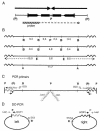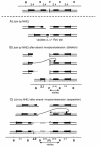Rapid, stabilizing palindrome rearrangements in somatic cells by the center-break mechanism
- PMID: 14612414
- PMCID: PMC262683
- DOI: 10.1128/MCB.23.23.8740-8750.2003
Rapid, stabilizing palindrome rearrangements in somatic cells by the center-break mechanism
Abstract
DNA palindromes are associated with rearrangement in a variety of organisms. A unique opportunity to examine the impact of a long palindrome in mammals is afforded by the Line 78 strain of mice. Previously it was found that the transgene in Line 78 is likely to be palindromic and that the symmetry of the transgene was responsible for a high level of germ line instability. Here we prove that Line 78 mice harbor a true 15.4-kb palindrome, and through the establishment of cell lines from Line 78 mice we have shown that the palindrome rearranges at the impressive rate of about 0.5% per population doubling. The rearrangements observed to arise from rapid palindrome modification are consistent with a center-break mechanism where double-strand breaks, created through hairpin nicking of an extruded cruciform, are imprecisely rejoined, thus introducing deletions at the palindrome center. Significantly, palindrome rearrangements in somatic tissue culture cells almost completely mirrored the structures generated in vivo in the mouse germ line. The close correspondence between germ line and somatic events indicates the possibility that center-break modification of palindromes is an important mechanism for preventing mutation in both contexts. Permanent cell lines carrying a verified palindrome provide an essential tool for future mechanistic analyses into the consequences of palindromy in the mammalian genome.
Figures








Similar articles
-
Palindrome resolution and recombination in the mammalian germ line.Mol Cell Biol. 1997 Sep;17(9):5559-70. doi: 10.1128/MCB.17.9.5559. Mol Cell Biol. 1997. PMID: 9271431 Free PMC article.
-
Palindromic DNA and genome stability. Further studies.Ann N Y Acad Sci. 1999 May 18;870:45-57. doi: 10.1111/j.1749-6632.1999.tb08864.x. Ann N Y Acad Sci. 1999. PMID: 10415472
-
Repeat expansion by homologous recombination in the mouse germ line at palindromic sequences.Proc Natl Acad Sci U S A. 2001 Jul 17;98(15):8326-33. doi: 10.1073/pnas.151008498. Proc Natl Acad Sci U S A. 2001. PMID: 11459971 Free PMC article.
-
Palindromes and genomic stress fractures: bracing and repairing the damage.DNA Repair (Amst). 2006 Sep 8;5(9-10):1146-60. doi: 10.1016/j.dnarep.2006.05.014. Epub 2006 Jun 30. DNA Repair (Amst). 2006. PMID: 16807136 Review.
-
Palindrome-Mediated Translocations in Humans: A New Mechanistic Model for Gross Chromosomal Rearrangements.Front Genet. 2016 Jul 12;7:125. doi: 10.3389/fgene.2016.00125. eCollection 2016. Front Genet. 2016. PMID: 27462347 Free PMC article. Review.
Cited by
-
A palindrome-mediated recurrent translocation with 3:1 meiotic nondisjunction: the t(8;22)(q24.13;q11.21).Am J Hum Genet. 2010 Aug 13;87(2):209-18. doi: 10.1016/j.ajhg.2010.07.002. Epub 2010 Jul 30. Am J Hum Genet. 2010. PMID: 20673865 Free PMC article.
-
Collaboration of homologous recombination and nonhomologous end-joining factors for the survival and integrity of mice and cells.Genes Dev. 2004 Jun 1;18(11):1293-304. doi: 10.1101/gad.1209204. Genes Dev. 2004. PMID: 15175261 Free PMC article.
-
Testing predictions of the double-strand break repair model relating to crossing over in Mammalian cells.Genetics. 2004 Nov;168(3):1539-55. doi: 10.1534/genetics.104.029215. Genetics. 2004. PMID: 15579705 Free PMC article.
-
E. coli SbcCD and RecA control chromosomal rearrangement induced by an interrupted palindrome.Mol Cell. 2010 Jul 9;39(1):59-70. doi: 10.1016/j.molcel.2010.06.011. Mol Cell. 2010. PMID: 20603075 Free PMC article.
-
Concatenation of Transgenic DNA: Random or Orchestrated?Genes (Basel). 2021 Dec 10;12(12):1969. doi: 10.3390/genes12121969. Genes (Basel). 2021. PMID: 34946918 Free PMC article. Review.
References
-
- Benham, C. J., A. G. Savitt, and W. R. Bauer. 2002. Extrusion of an imperfect palindrome to a cruciform in superhelical DNA: complete determination of energetics using a statistical mechanical model. J. Mol. Biol. 316:563-581. - PubMed
-
- Cunningham, L. A. 2002. Characterization of palindrome instability in mammalian cell lines. Masters thesis. University of Toronto, Toronto, Canada.
Publication types
MeSH terms
Substances
LinkOut - more resources
Full Text Sources
